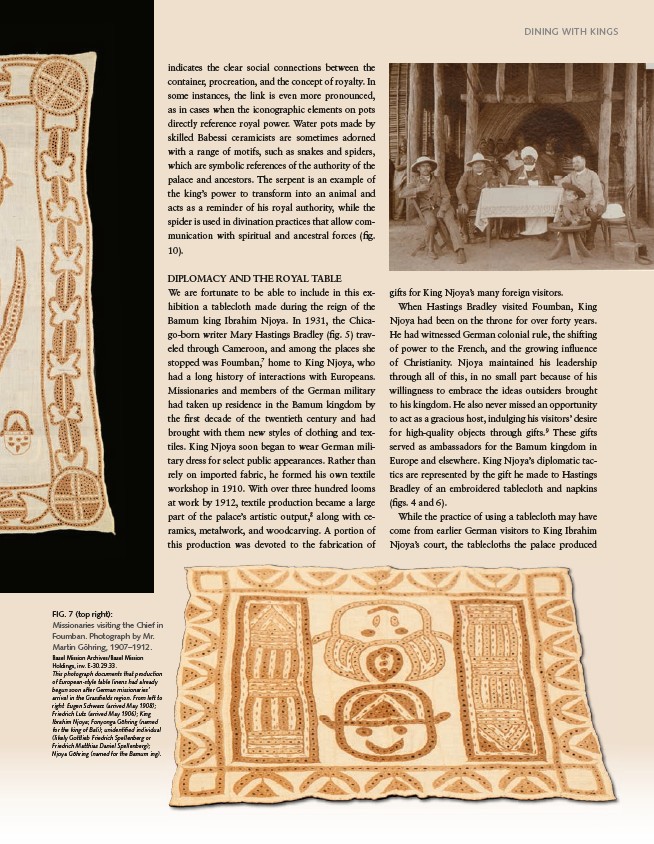
DINING WITH KINGS
indicates the clear social connections between the
container, procreation, and the concept of royalty. In
some instances, the link is even more pronounced,
as in cases when the iconographic elements on pots
directly reference royal power. Water pots made by
skilled Babessi ceramicists are sometimes adorned
with a range of motifs, such as snakes and spiders,
which are symbolic references of the authority of the
palace and ancestors. The serpent is an example of
the king’s power to transform into an animal and
acts as a reminder of his royal authority, while the
spider is used in divination practices that allow communication
with spiritual and ancestral forces (fi g.
10).
DIPLOMACY AND THE ROYAL TABLE
We are fortunate to be able to include in this exhibition
a tablecloth made during the reign of the
Bamum king Ibrahim Njoya. In 1931, the Chicago
born writer Mary Hastings Bradley (fi g. 5) traveled
through Cameroon, and among the places she
stopped was Foumban,7 home to King Njoya, who
had a long history of interactions with Europeans.
Missionaries and members of the German military
had taken up residence in the Bamum kingdom by
the fi rst decade of the twentieth century and had
brought with them new styles of clothing and textiles.
King Njoya soon began to wear German military
dress for select public appearances. Rather than
rely on imported fabric, he formed his own textile
workshop in 1910. With over three hundred looms
at work by 1912, textile production became a large
part of the palace’s artistic output,8 along with ceramics,
metalwork, and woodcarving. A portion of
this production was devoted to the fabrication of
gifts for King Njoya’s many foreign visitors.
When Hastings Bradley visited Foumban, King
Njoya had been on the throne for over forty years.
He had witnessed German colonial rule, the shifting
of power to the French, and the growing infl uence
of Christianity. Njoya maintained his leadership
through all of this, in no small part because of his
willingness to embrace the ideas outsiders brought
to his kingdom. He also never missed an opportunity
to act as a gracious host, indulging his visitors’ desire
for high-quality objects through gifts.9 These gifts
served as ambassadors for the Bamum kingdom in
Europe and elsewhere. King Njoya’s diplomatic tactics
are represented by the gift he made to Hastings
Bradley of an embroidered tablecloth and napkins
(fi gs. 4 and 6).
While the practice of using a tablecloth may have
come from earlier German visitors to King Ibrahim
Njoya’s court, the tablecloths the palace produced
FIG. 7 (top right):
Missionaries visiting the Chief in
Foumban. Photograph by Mr.
Martin Göhring, 1907–1912.
Basel Mission Archives/Basel Mission
Holdings, inv. E-30.29.33.
This photograph documents that production
of European-style table linens had already
begun soon after German missionaries’
arrival in the Grassfi elds region. From left to
right: Eugen Schwarz (arrived May 1908);
Friedrich Lutz (arrived May 1906); King
Ibrahim Njoya; Fonyonga Göhring (named
for the king of Bali); unidentifi ed individual
(likely Gottlieb Friedrich Spellenberg or
Friedrich Matthias Daniel Spellenberg);
Njoya Göhring (named for the Bamum ing).